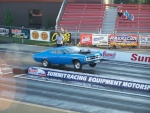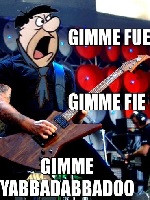Ladder Bar Help/
4 posters
Page 1 of 1
 Ladder Bar Help/
Ladder Bar Help/
I need some help on where my D/s and rear pinion angle should be.
I have 3 deg upward on the driveshaft. The rear of the D/Shaft is pointed up towards the floor.
The pinion angle is pointed about 3 deg down towards the floor.
Should the D/S be pointed downward a little bit like 2-3 degrees?
Car is 60 ft at 1.35s
Thanks Tore
I have 3 deg upward on the driveshaft. The rear of the D/Shaft is pointed up towards the floor.
The pinion angle is pointed about 3 deg down towards the floor.
Should the D/S be pointed downward a little bit like 2-3 degrees?
Car is 60 ft at 1.35s
Thanks Tore

Tore- Posts : 865
Join date : 2009-08-19
 Re: Ladder Bar Help/
Re: Ladder Bar Help/
Pinion angle has squat to do with hooking, its about keeping the ujoints happy

richter69- Posts : 13649
Join date : 2008-12-02
Age : 53
Location : In the winners circle
 Re: Ladder Bar Help/
Re: Ladder Bar Help/
On a ladder bar car it generally recommended that the rear u-joint angle be 1.5 -2 degrees with the open side of the Vee at the top. On stock chassis cars it is usually pretty difficult to achieve absolute perfection at both ends of the drive-shaft.
Don't worry about the angle to the ground just worry about the angle between the pinion and the drive-shaft.
dkp
Don't worry about the angle to the ground just worry about the angle between the pinion and the drive-shaft.
dkp

bosshoss- BBF CONTRIBUTOR

- Posts : 499
Join date : 2009-08-10
 Re: Ladder Bar Help/
Re: Ladder Bar Help/
In setting up/building a "drag-only" car (never sees street-highway use) with an aftermarket type rear suspension (ladder bar or "drag" 4-link) you initially want to set up the driveline angles so that while the car is sitting at full weight ride height the pinion C/L points directly at the trans tail shaft C/L, & the trans tail shaft C/L points directly at the pinion C/L (being "on centerline" & parallel at the same time). This initial setup setting gives you a 0.00 degree U-joint operating angle/interference angle running through both U-joints. Then you adjust in a small given amount of negative pinion angle between the pinion's C/L & the driveshaft's C/L to offset X amount of upward pinion rotation that's happening during launch loading. Doing this will usually give you a slip yoke positive U-joint operating angle that's roughly 1/2 the negative pinion U-joint operating angle while the car isn't under launch loading (at rest). As an example using this setup method, if the pinion angle was set at -1.00* U-joint operating angle, the slip yoke angle would be roughly +0.50* U-joint operating angle (at rest). The idea is to have as close to 0.00 degrees of U-joint offset/misalignment angle/operating angle during launch loading for the lowest possible binding/frictional losses at-through the U-joints. And having the U-joints at/around 0.00* operating angle (under load) helps driveshaft/U-joint assemblies to have the highest possible safe "prop speed" RPM numbers. In this application "drag" 4-links generally are set anywhere in the -0.75* to -1.25* (and sometimes a little more) pinion operating angle range (at rest) depending on the rest of the car's total combo & intended use. And ladder bars are generally set in the -1.00* to -1.50* (and sometimes a little more) range depending again on the total combo & intended use.
How much negative pinion angle is actually truly "required" on any drag-only car to offset upward pinion rotation during the launch (to achieve as close to 0.00* U-joint operating angles under load) really depends on how much upward pinion rotation any given rear suspension type is actually possible of generating under loading.
You don't ever want to use this setup method on any car that will ever see any street-highway-high mileage use. This is because there may not be enough U-joint operating angle at either U-joint to promote enough needle bearing surface rotation & self-lubrication of all the bearing surfaces over the extended use that street cars see. Setting up a street-highway use car's driveline operating angles is a different method. It basically requires that at ride height both U-joints have as close to "equal-but-apposing" operating angles (aka being "in phase" or being "off centerline" but still parallel at the same time) as possible at both U-joints. So as an example with this method if the slip yoke to driveshaft operating angle is +2.00*, then the pinion to driveshaft operating angle would be -2.00*.
How much negative pinion angle is actually truly "required" on any drag-only car to offset upward pinion rotation during the launch (to achieve as close to 0.00* U-joint operating angles under load) really depends on how much upward pinion rotation any given rear suspension type is actually possible of generating under loading.
You don't ever want to use this setup method on any car that will ever see any street-highway-high mileage use. This is because there may not be enough U-joint operating angle at either U-joint to promote enough needle bearing surface rotation & self-lubrication of all the bearing surfaces over the extended use that street cars see. Setting up a street-highway use car's driveline operating angles is a different method. It basically requires that at ride height both U-joints have as close to "equal-but-apposing" operating angles (aka being "in phase" or being "off centerline" but still parallel at the same time) as possible at both U-joints. So as an example with this method if the slip yoke to driveshaft operating angle is +2.00*, then the pinion to driveshaft operating angle would be -2.00*.

DILLIGASDAVE- Posts : 2262
Join date : 2009-08-08
Location : Texas. pronounced "texASS"
 Similar topics
Similar topics» Ladder bar with ARB ?
» Ladder Bar Adj.
» Ladder Bar ???
» F-100 Ladder bar set up
» ladder bar questions
» Ladder Bar Adj.
» Ladder Bar ???
» F-100 Ladder bar set up
» ladder bar questions
Page 1 of 1
Permissions in this forum:
You cannot reply to topics in this forum